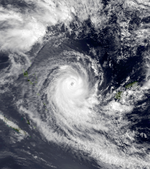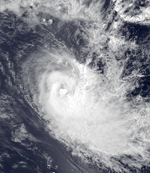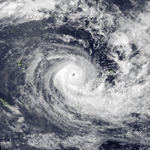1982–83 South Pacific cyclone season
| 1982–83 South Pacific cyclone season |

Season summary map
|
| Seasonal boundaries |
| First system formed |
October 31, 1982 |
| Last system dissipated |
April 23, 1983 |
| Strongest storm |
|
| Name |
Oscar |
| • Maximum winds |
205 km/h (125 mph)
(10-minute sustained) |
| • Lowest pressure |
920 hPa (mbar) |
| Seasonal statistics |
| Total depressions |
16 |
| Tropical cyclones |
14 |
| Severe tropical cyclones |
10 (record high)
|
| Total fatalities |
Unknown |
| Total damage |
Unknown |
| Related articles |
|
|
South Pacific tropical cyclone seasons
1980–81, 1981–82, 1982–83, 1983–84, 1984–85
|
| Category 2 tropical cyclone (Australian scale) |
| Category 1 tropical cyclone (SSHWS) |
|
|
| Duration |
October 30 – November 8 |
| Peak intensity |
110 km/h (70 mph) (10-min) 975 hPa (mbar) |
| Category 1 tropical cyclone (Australian scale) |
| Tropical storm (SSHWS) |
|
|
| Duration |
November 6 – November 13 |
| Peak intensity |
75 km/h (45 mph) (10-min) 990 hPa (mbar) |
| Category 2 tropical cyclone (Australian scale) |
| Tropical storm (SSHWS) |
|
|
| Duration |
December 10 – December 18 |
| Peak intensity |
110 km/h (70 mph) (10-min) 975 hPa (mbar) |
| Category 3 severe tropical cyclone (Australian scale) |
| Category 1 tropical cyclone (SSHWS) |
|
|
| Duration |
January 20 – February 1 |
| Peak intensity |
150 km/h (90 mph) (10-min) 955 hPa (mbar) |
| Category 3 severe tropical cyclone (Australian scale) |
| Category 1 tropical cyclone (SSHWS) |
|
|
| Duration |
January 21 – January 29 |
| Peak intensity |
120 km/h (75 mph) (10-min) 970 hPa (mbar) |
| Category 4 severe tropical cyclone (Australian scale) |
| Category 3 tropical cyclone (SSHWS) |
|
|
| Duration |
February 13 – February 28 |
| Peak intensity |
185 km/h (115 mph) (10-min) 925 hPa (mbar) |
| Category 5 severe tropical cyclone (Australian scale) |
| Category 3 tropical cyclone (SSHWS) |
|
|
| Duration |
February 23 – March 6 |
| Peak intensity |
205 km/h (125 mph) (10-min) 920 hPa (mbar) |
| Category 1 tropical cyclone (Australian scale) |
| Tropical storm (SSHWS) |
|
|
| Duration |
February 25 – March 6 |
| Peak intensity |
85 km/h (50 mph) (10-min) 987 hPa (mbar) |
| Category 4 severe tropical cyclone (Australian scale) |
| Category 2 tropical cyclone (SSHWS) |
|
|
| Duration |
March 7 – March 15 |
| Peak intensity |
185 km/h (115 mph) (10-min) 925 hPa (mbar) |
The 1982–83 South Pacific cyclone season was one of the most active and longest South Pacific tropical cyclone seasons on record, with 14 tropical cyclones occurring within the South Pacific basin between 160°E and 120°W. During the season tropical cyclones were monitored by the meteorological services of Australia, Fiji, French Polynesia and New Zealand. The United States Armed Forces through the Joint Typhoon Warning Center (JTWC) and Naval Pacific Meteorology and Oceanography Center (NPMOC), also monitored the basin and issued unofficial warnings for American interests. The first tropical cyclone of the season developed a day before the season officially began on October 31, while the last tropical cyclone of the season dissipated on April 23. Most of the activity during the season occurred within the central and eastern parts of the basin with French Polynesia affected by several systems.
The 1982–83 season was one of the most active and longest South Pacific tropical cyclone seasons on record, with 14 tropical cyclones occurring within the South Pacific basin between 160°E and 120°W. The season was characterised by a very strong El Niño Event, which resulted in eleven tropical cyclones occurring to the east of the International Dateline. Five of these tropical cyclones went on to affect the island nation of French Polynesia, which it was thought had not been affected by a tropical cyclone since another very strong El Nino episode in 1905-06.
During the season, ten of the fourteen tropical cyclones observed to the east of 160 E were severe tropical cyclones, with 5 of them occurring in the French Polynesia region which represented one more than was experienced in the same area over the previous 13 seasons.
...
Wikipedia


















